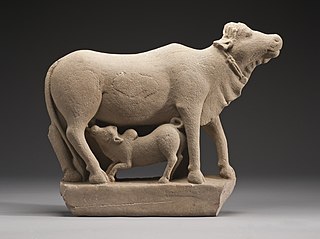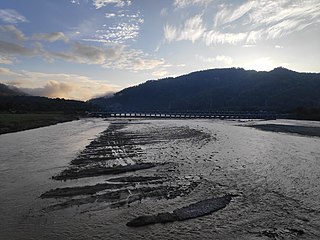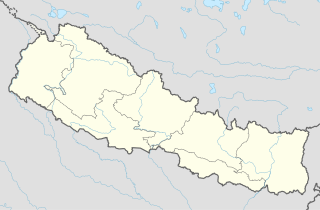
Animal sacrifice is the ritual killing and offering of one or more animals, usually as part of a religious ritual or to appease or maintain favour with a deity. Animal sacrifices were common throughout Europe and the Ancient Near East until the spread of Christianity in Late Antiquity, and in and continue in some cultures or religions today. Human sacrifice, where it existed, was always much rarer.

Due to the multiple benefits from cattle, there are varying beliefs about cattle in societies and religions. In some regions, especially most states of India, the slaughter of cattle is prohibited and their meat may be taboo.

Bara District lies in Madhesh Province. It is one of the seventy-seven districts of Nepal. The district is third richest district in Nepal after Kathmandu and Morang with 3.3% share of total GDP of Nepal and per capita income is highest in Madhesh province. Kalaiya as its district headquarters, covers an area of 1,190 km2 (460 sq mi) and has a population (2011) of 687,708. Bakaiya, Jamuniya, Pasaha, Dudhaura and Bangari are the main rivers of Bara. The main languages spoken in Bara are Bhojpuri, Bajjika, Tharu and Nepali.

Sarlahi, a part of Madhesh Province, is one of the seventy-seven districts of Nepal. According to new laws, a combination of more than two or four villages makes a municipality, which covers an area of 1,259 km2 (486 sq mi) and had a population of 635,701 in 2001 and 769,729 in 2011.

The killing of animals is animal euthanasia, animal sacrifice, animal slaughter, hunting, blood sports, roadkill or self-defense.

Dashain (Nepali), is a major religious festival in Nepal and some parts of India. Dashain called Dussehra in India is celebrated by the Hindus of India and Nepal as well as elsewhere in the world and among the Lhotshampa of Bhutan and the Burmese Gurkhas of Myanmar. A version of this festival is celebrated as Navaratri or Dashera by Hindus in India, although rites and rituals vary significantly.

Birgunj is a metropolitan city in Parsa District in Madhesh Province of southern Nepal. It lies 135 km (84 mi) south of the capital Kathmandu, attached in the north to Raxaul in the border of the Indian state of Bihar. As an entry point to Nepal from Patna and Kolkata, Birgunj is known as the "Gateway to Nepal". It is also called "Commercial capital of Nepal". The town has significant economic importance for Nepal as most of the trade with India is via Birgunj and the Indian town of Raxaul. Tribhuvan Highway links Birgunj to Nepal's capital, Kathmandu. Birgunj was one of the first three municipalities formed during the rule of Prime Minister Mohan Shumsher Jang Bahadur Rana. It was declared a Metropolitan City on 22 May 2017 along with Biratnagar and Pokhara. Birgunj is one of the largest city in Nepal and largest in Madhesh Province. Birgunj is the sixth most populated metropolis of the nation.

Khokana is a former Village Development Committee (VDC) which has been merged with the neighbouring VDC's of Bungamati, Chhampi, Dukuchhap, Sainbu and other 38 VDC's to form the Metropolitan City of Lalitpur in Lalitpur District in the Bagmati Zone of central Nepal. At the time of the 1991 Nepal census, Khokana had a population of 4258 living in 699 individual households. According to 2011 Nepal census, Khokana had a population of 4927 living in 1056 individual households.

Bariyarpur was a town and Village Development Committee in Bara District but now it is converted into municipality in the Narayani Zone of south-eastern Nepal. At the time of the 2001 Nepal census it had a population of 10000 persons residing in 1250 individual households.
Dumarwana is a town in Gadhimai Municipality in Bara District in the Narayani Zone of south-eastern Nepal. The formerly Village Development Committee was merged to form new municipality since 18 May 2014. At the time of the 2011 Nepal census it had a population of 21,470 persons living in 4,416 individual households. There were 10,228 males and 11,242 females at the time of census.
Fattepur is a town in Jitpur Simara Sub Metropolitan City in Bara District in the Narayani Zone of south-eastern Nepal. The formerly Village Development Committee was merged to form new municipality on 18 May 2014. Fattepur falls under ward council number 12 of Jitpur Simara Sub Metropolitan City. At the time of the 2011 Nepal census it had a population of 8,890 persons living in 1,504 individual households. Its elevation is 377 ft. There were 4,521 males and 4,369 females in the 2011 census.

Nijgadh is a town and municipality in Bara District in the Narayani Zone, Madhesh Province of south-eastern Nepal. The existing Nijgadh VDC was merged with the existing Ratnapuri VDC and Bharatganj Singaul VDC in May 2014.

Pipara Simara is a town in Jitpursimara sub-metropolitan city in Bara District in Province No. 2 of south-eastern Nepal. The formerly Village Development Committee was merged to form a new municipality Gadhimai Municipality on 18 May 2014. Similarly, on 10 March 2017 Gadhimai Municipality, Inarwasira, Amlekhganj, as well as parts of Manharwa, Haraiya and Rampur Tokani were merged to form new Jitpursimara sub-metropolitan city. Aauraha, Ramban, Narbasti,Bajani etc are the village in Simara.Auraha lies in the east, Bajani in the south, Ramban & Narbasti in the west. At the time of the 2011 Nepal census it had a population of 23,835 people living in 5,253 individual households.

Bhimad is a municipality in Tanahu District in the Gandaki Zone of central Nepal. At the time of the 2011 Nepal census the city had a population of 8,414 people living in 2,191 individual households. It is 30 minutes away from Khairenitar. Due to its historic importance, a plan is underway to incorporate the Shukla Gandaki municipality and form the Bhimad Sub-metropolitan City in the near future. This is being done in order to improve the integrated development of this region because the city is currently experiencing accelerated development. While Bhimad lacks sufficient hospital facilities for its population size, there are many health centers in various communities.

Gamhariya was a village development committee in Rautahat District in the Narayani Zone of south-eastern Nepal.

Jeetpursimara is a sub-metropolitan city in Bara District in Province No. 2 of southern Nepal that was formed on 10 March 2017 after merging Gadhimai Municipality, Inarwasira, Amlekhganj, as well as parts of Manharwa, Haraiya and Rampur Tokani to form a new sub-metropolitan city. At the time of the 2011 Nepal census, the former settlements that would make up the sub-metropolitan city had a joint population of 117,094 people living in 21,670 individual households.

Gadhimai festival is a religious festival held every five years in Nepal at the Gadhimai Temple of Bariyarpur, in Bara District, about 160 kilometres (99 mi) south of the capital Kathmandu, and about 7 kilometres (4.3 mi) east of the city of Kalaiya, near the Indo-Nepal border. It is primarily celebrated by Madhesi people. The event involves large-scale sacrificial slaughter of animals, including water buffalo, pigs, goats, chickens, and pigeons, with the goal of pleasing Gadhimai, the goddess of power. People also offer coconuts, sweets, red-coloured clothes, etc. The festival has been described as the world's largest animal sacrifice event or one of the largest.

Gadhimai Temple is a temple of Gadhimai Devi, an aspect of Kali, the Hindu goddess of power. The temple is situated in Mahagadhimai Municipality in Bara District of south central Nepal, though the term usually refers to Gadhimai festival, conducted at the Gadhimai temple area in central Terai of Nepal.

The practice of Hindu animal sacrifice is mostly associated with Vedic Śrauta rituals, Shaktism, and in currents of folk Hinduism strongly rooted in local popular or tribal traditions, however animal sacrifices were part of the ancient Vedic religion in India, and are mentioned in scriptures such as the Yajurveda. Seven of the twenty one Vedic Srauta Yagnyas require animal sacrifices. The famous ones are the goat in Soma Yaga and the horse in Ashvamedha.The eighteen major Puranas and Upapuranas like the Kalika Purana prescribe animal sacrifice. The practice never declined during the formation of Hinduism, and very many Hindus strongly approve of them. Buddhists, Jains and Neo-Hindu movements like Arya Samaj alongwith western organizations like PETA have questioned such orthodox rituals. Some Indian states like Kerala have legally banned such practices under such influence. The famous Kalighat temple, to which Kolkata owes its name sees hundreds of sacrifices everyday.

















